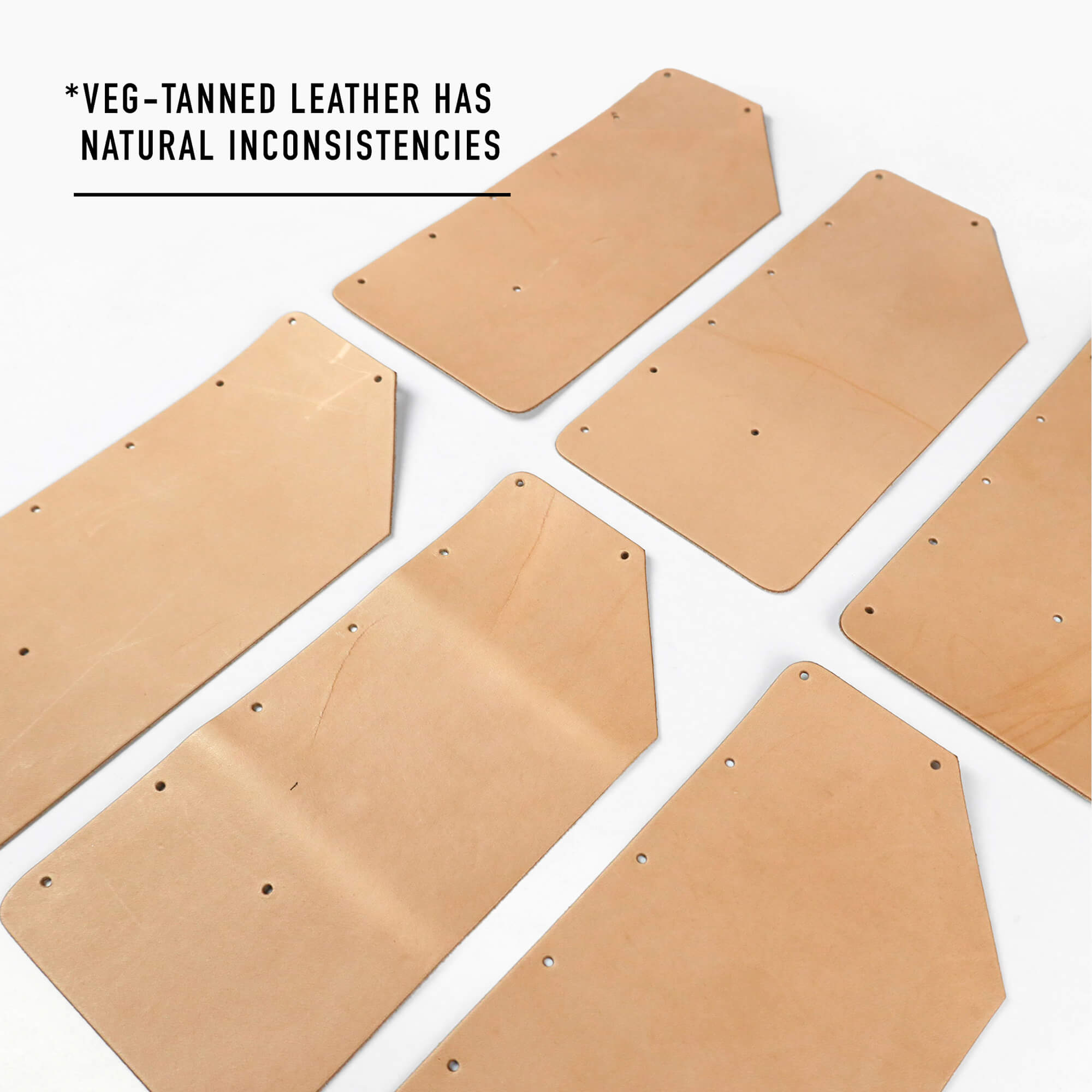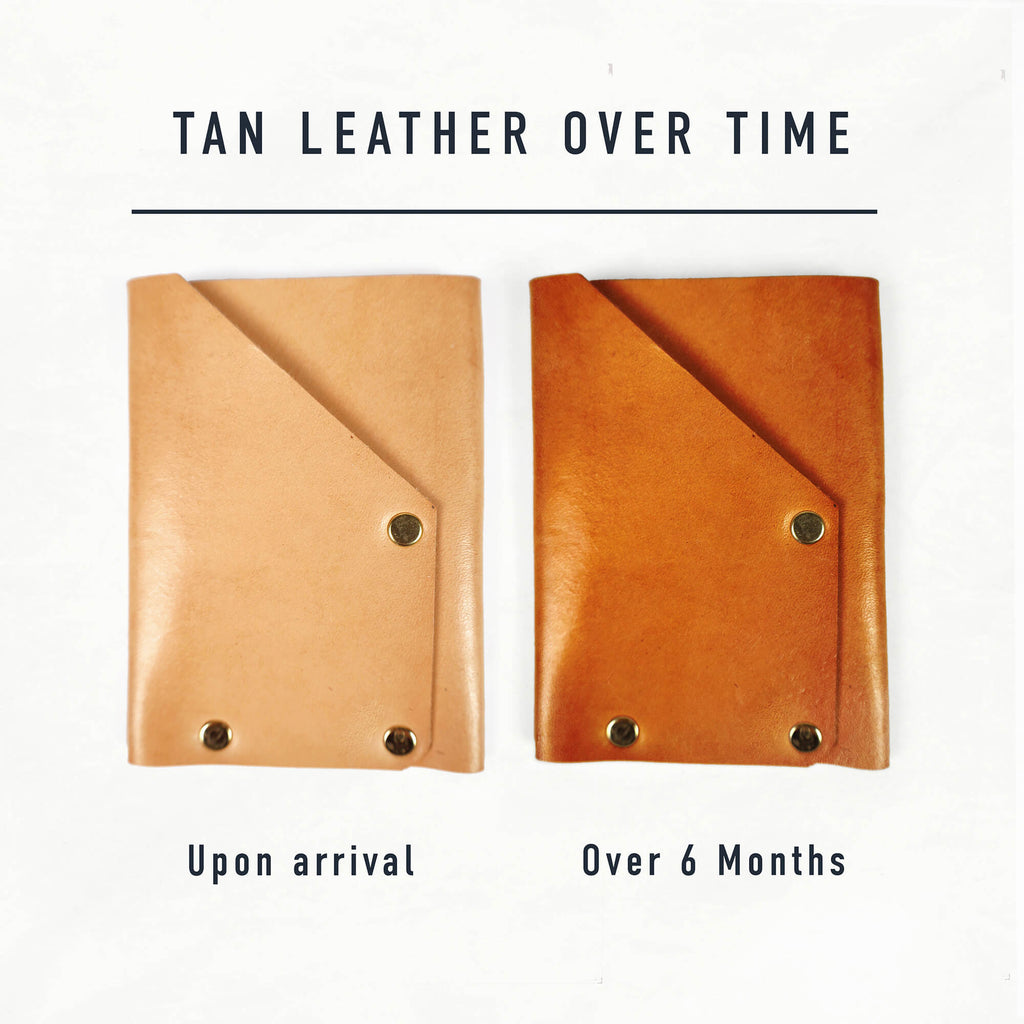Here at Klum House, we love working with natural, heritage materials. When making bags, we’re always looking for that perfect combination of durability, function, and beauty.
Vegetable-tanned leather checks all of these boxes and more. All the leather at Klum House is vegetable-tanned leather, even the black and chestnut leather. In this post, we’re going to take a deep-dive into the world of vegetable-tanned leather, covering how it’s made, what makes it unique, and how best to care for it.
WHAT IS VEGETABLE-TANNED LEATHER?

The process through which animal hides are turned into leather is referred to as tanning. Humans have been tanning leather for thousands of years. In short, tanning changes the chemistry of the hide to preserve it, make it durable, and protect it from moisture and microorganisms. Vegetable tanning, which uses natural tannins extracted from tree bark, leaves, and roots, is the oldest tanning method.
Today, only about 10% of the world’s leather is vegetable-tanned, while “chrome-tanned” leather (like the black and brown leather in our kits) accounts for almost all the rest. This is partly because veg-tanned leather takes much longer to make (up to two months!), while chrome-tanned leather can be processed in a single day. As a result of this slower, traditional process, veg-tanned leather has a distinct aesthetic and impressive durability. If well cared for, it can easily last a lifetime.
 |
Because it lacks a synthetic coating and is a light, natural color, veg-tanned leather tends to show more natural imperfections than chrome-tanned leather. It is an organic material, which sometimes comes with blemishes like bug bites or stretch marks. These "flaws" have no affect whatsoever on the quality or durability of the leather. On the contrary, they give the leather added texture and story, all of which blends into a lovely, worn-in patina with time. Also, as veg-tan inevitably darkens in color, these imperfections become almost imperceptible. |
COLOR + TEXTURE CHANGES OVER TIME

|
When veg-tanned leather is new, it’s often a light tan color with some natural variation from the tanning process. You’ll probably also notice that it feels more stiff than other types of leather, but don’t worry—it won’t stay that way for long! One of the coolest things about veg-tanned leather is that it changes as it ages, darkening into a deep caramel brown and gradually becoming very soft and supple. Unlike other types of leather, veg-tanned leather is free from synthetic coatings. This means it’s able to absorb moisture and oils. With use and exposure to the elements, veg-tanned leather develops a beautiful, storied patina. These elements affect the way veg-tanned leather looks and feels: |
WATERVeg-tanned leather, when unprotected, is easily stained by water. Unless you’re down to embrace the stains, we recommend keeping it dry, or treating it with a water-resistant leather salve (more on that below!). |
|

|
SUNLIGHT
Believe it or not, veg-tanned leather can get sunburned! It’s skin, after all. If any part of it is left in direct sunlight, that part will darken. Again, this isn’t a bad thing, just a unique characteristic of the material. It will add to the patina over time. |
OILAnother element that affects the color and texture of veg-tanned leather is oil—especially from your hands. If you are using and handling your bag everyday, the color will darken and the texture will soften. You also can condition your leather with oil intentionally! |

|
|
|
DIRTBecause veg-tanned leather has a porous surface, dirt is more likely to collect on its surface than synthetically-treated leather. Usually it simply blends in and becomes part of the weathered patina, but if the dirt bothers you, read on to learn how to clean with saddle soap. |

Water stains on veg-tanned wallet untreated with leather salve
HOW TO CARE FOR VEG-TANNED LEATHER
To ensure that your veg-tanned leather lasts a long time and stays looking its best, we highly recommend taking the time to protect and condition it. Here are some of our favorite products for caring for all types of leather, but vegetable-tanned especially. All of them come from a Portland-based company called Otter Wax.

1. PROTECT + CONDITION
The best way to protect leather, especially new veg-tanned leather, which is porous and and more vulnerable to the elements, is by applying a deep conditioning treatment like leather salve. Otter Wax's leather salve is made from a blend of natural waxes, oils, and butters. We recommend applying it in small circles with this horsehair brush. The wax in the salve adds a layer of water resistance. It also slightly darkens the color and makes the leather feel very soft. Immediately after applying the salve with the brush, it might look a little blotchy or uneven, but don't worry! Wait 30 minutes to let the salve soak in. Then buff away any excess with a flannel buffing cloth, which will remove any stickiness from the wax and give the leather a nice even shine. For detailed instructions, check out this blog post from the manufacturer.
2. HYDRATE + SHINE
Leather oil is another product that's great for moisturizing and shining your leather. Otter Wax's leather oil is made from a blend of high-oleic safflower oil with vitamin-E and sweet orange oils. It can also be applied with a horsehair buffing brush. Unlike the salve, leather oil does not contain wax, so it doesn't have that same water-resistant quality, but it does help prevent and repair dry cracking, scuffs, and minor scratches. Like the salve, it will also slightly darken the color of veg-tanned leather, essentially speeding up the natural deepening that otherwise happens over time. For detailed instructions, check out this blog post from the manufacturer.
3. CLEAN + RESTORE
When your leather inevitably collects some dirt of stains over time, it's totally possible to clean it and restore it to its former beauty. Otter Wax makes a product called saddle soap, which is formulated from a blend of all-natural beeswax, castile soap, and essential oils, and is designed to gently cleanse and revive leather. Saddle soap is best applied with a Tampico cleaning brush, which has natural bristles stiff enough to scrub away dirt and stains, but soft enough to not scratch the leather. When you've finished scrubbing, wipe clean with a warm, damp, lint-free cloth. For detailed instructions, check out this blog post from the manufacturer.










